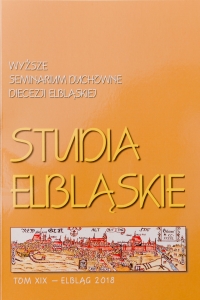Dekoracja malarska kościoła w Rodowie jako przykład nowych źródeł ikonografii sztuki luterańskiej w Prusach Książęcych
The painted decoration of the Church in Rodowo as an example of new sources of iconographz of protestant art in Ducal Prussia
Author(s): Piotr BireckiSubject(s): Architecture, Local History / Microhistory, Modern Age, History of Art
Published by: Wyższe Seminarium Duchowne Diecezji Elbląskiej w Elblągu
Keywords: Reformation; Protestant art; Ducal Prussia; emblems; Louis XIV; Claude Perrault; Charles Le Brun; Pietism
Summary/Abstract: This article investigates the artistic program of the eighteenth-century Lutheran church in Rodowo as an example of new sources of protestant iconography in Ducal Prussia. The article presents the history of the village, the history of the family von Schack as the owners of the village and the history of the church in Rodowo. Family of Schacks was the founder of the church and the founders of the decorations. The paper presents the emblem decorationson the benches based on the projects of tapestries for Louis XIV as a projects of Charles le Brun and Charles Perrault, and four oval paintings located in the western part of the church. The author imply that those paintings are the example of the influences of Pietism on area of Ducal Prussia. The emblems identified among the paintings in the panels of the Rodowo church benches are copies of the interpretations offered by the authors of "Quatre elemens" and "Quatre saisons" engraved by Sébastien Le Clerc. An unknown painter used in Rodowo probably the first German editions appeared in Augsburg in 1687 and 1690 by Jacob Koppmayer for Johann Ulrich Krauss.Maybe the painted decorations of the church in Rodowo are an idealized image of the order of the tree estates in Ducal Prussia? The unique set of paintings is the visible visualization of the relationship between the clergy, the peasants, and, above all, the Lutheran ruler of the village. In Ducal Prussia, only in Rodowo did the local nobles create such strong lines of communication. The images (which are depicted on the benches and on the four great paintings) are the kind of message sent by the owners of Rodowo village to the peasant population about their respective status in life: the rulers should follow the rules as set down in theemblems, the peasants should learn how to pray properly. They also received a visual model of social structure. The preachers had reminders of their sermons written on the walls. The images demonstrate the relationship between the Lutheran landlord, his peasants and the local pastor. The final chapter discusses the sources of the traditional and new iconography in protestant churches in Ducal Prussia. The most compositions of paintings in Prussia were based on biblical illustrations of Lucas Cranach (Koenigsberg), Albrecht Dürer (Rychnowo), Matthäus Merian (Dąbrówno) and graphics of Sadeler family, Hendrick Goltzius, Maerten de Vos or Crispijn van de Passe (older paitnings Rodowo). In XVII and at the beginning of XVIII Century decorations were based on Pia Desideria by Jesuit Hermann Hugo (Stare Miasto near Dzierzgoń) or on Otto van Veenius’ Amori divini emblemata (Pasłęk). The decoration in the church in Rodowo is an interesting example of the influence of French culture in Ducal Prussia and among the local nobility, too. This influence is only apparent in the architecture of the greatest palaces in Prussia (Drogosze, Friedrichstein and Finckenstein) but also in the paintings – first example of secular sources of inspirations in the church interior in Rodowo.
Journal: Studia Elbląskie
- Issue Year: 2018
- Issue No: 19
- Page Range: 155-172
- Page Count: 18
- Language: Polish

